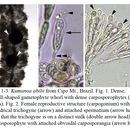ar
الأسماء في صفحات التنقل


Type Locality: Maia, Portugal.
Distribution: Europe: Portugal, South America: Brazil
Information about Kumanoa abili on Algaebase.
Information about Kumanoa abilii on GenBank.
"Plants moderately mucilaginous, delicate; branching irregular and abundant; apices straight, apical cells embedded within the fascicles; 2.0-6.0 cm high, 250-500 µm in diameter. Whorls well developed, usually distinct and separated, obconical, pear-shaped, barrel-shaped or spherical. Internode 200-750 µm long. Pericentral cells ovoid with 2-4 primary fascicles; rhizoidal filaments well developed, forming 1-2 layers of cylindrical cells. Primary fascicles straight, 7-12 cell-storeys, proximal cells cylindrical or elliptical, L/D 2.5-6; distal cells elliptical, obovoid or pear-shaped, L/D 1.5-3.5; branching di or trichotomous. Secondary fascicles abundant, covering two-thirds to the entire internode and as long as primary fascicles.
Monoecious. Spermatangia obovoid or spherical, terminal on primary or secondary fascicles, 4.0-6.0 µm in diameter. Carpogonial branches straight or curved, rarely slightly helically twisted, arising from pericentral or proximal cells of primary fascicles, rarely on secondary fascicles or intercalary cells of carpogonial branches, composed of 2-8 disc- or barrel-shaped cells; involucral filaments short, 1-5 cell-storeys; carpogonia (30-)35-60 µm long; trichogynes cylindrical, club-shaped or elongate-elliptical or bottle-shaped, unstalked or stalked, 6.0-9.0 µm in diameter. Carposporophytes 1, rarely 2 per whorl, dense, semi-spherical, lower than the whorl radius, 150-400 µm in diameter, 80-170 µm high; gonimoblast filaments 3-6 cell storeys; cells cylindrical or elliptical; carposporangia obovoid, 12.0-19.0 µm long, 7.5-12.0 µm in diameter."
Necchi, O. Jr. & Vis, M.L. 2012. Monograph of the genus Kumanoa (Rhodophyta, Batrachospermales). Bibliotheca Phycologica 116. J. Cramer. Pp. 78. ISBN 978-3-443-60043-3.
Kumano, S. 2002. Freshwater red algae of the world. Biopress Ltd. 375pp.
Reis, M. P. dos. 1965. Subsidios para o conhecimento das Rodoficeas de agua doce de Portugal. V. Bol. Soc. Brot. 32: 33-47.